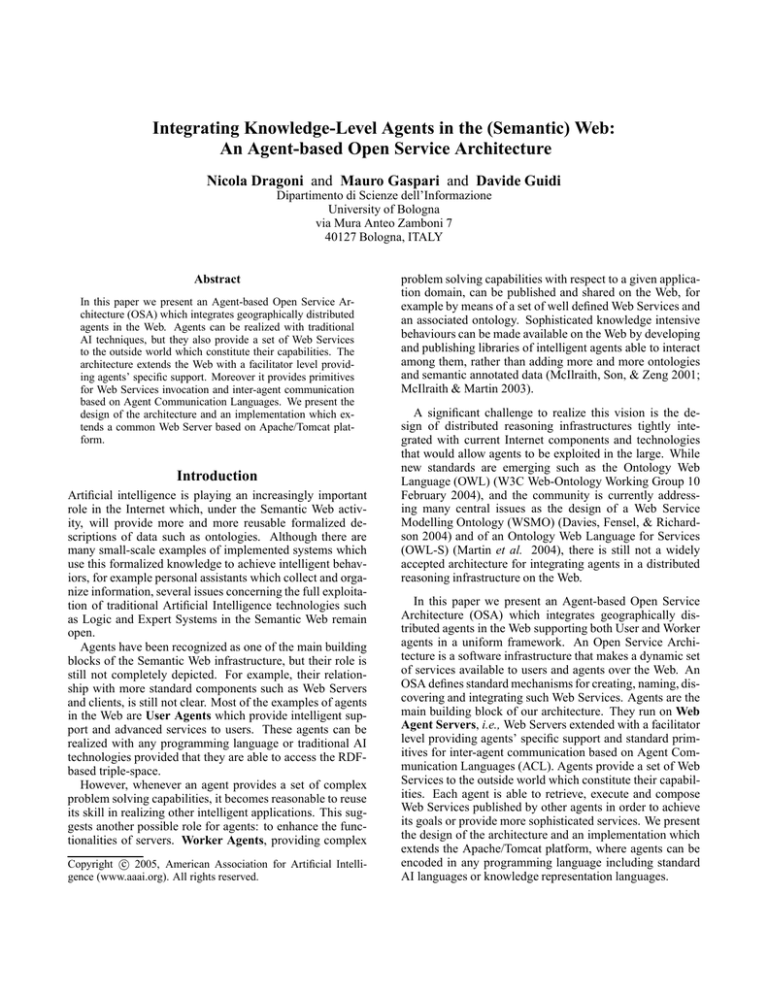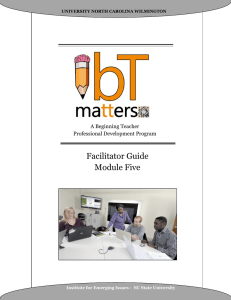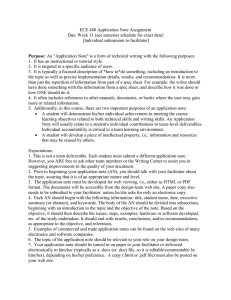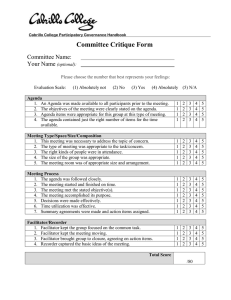
Integrating Knowledge-Level Agents in the (Semantic) Web:
An Agent-based Open Service Architecture
Nicola Dragoni and Mauro Gaspari and Davide Guidi
Dipartimento di Scienze dell’Informazione
University of Bologna
via Mura Anteo Zamboni 7
40127 Bologna, ITALY
Abstract
In this paper we present an Agent-based Open Service Architecture (OSA) which integrates geographically distributed
agents in the Web. Agents can be realized with traditional
AI techniques, but they also provide a set of Web Services
to the outside world which constitute their capabilities. The
architecture extends the Web with a facilitator level providing agents’ specific support. Moreover it provides primitives
for Web Services invocation and inter-agent communication
based on Agent Communication Languages. We present the
design of the architecture and an implementation which extends a common Web Server based on Apache/Tomcat platform.
Introduction
Artificial intelligence is playing an increasingly important
role in the Internet which, under the Semantic Web activity, will provide more and more reusable formalized descriptions of data such as ontologies. Although there are
many small-scale examples of implemented systems which
use this formalized knowledge to achieve intelligent behaviors, for example personal assistants which collect and organize information, several issues concerning the full exploitation of traditional Artificial Intelligence technologies such
as Logic and Expert Systems in the Semantic Web remain
open.
Agents have been recognized as one of the main building
blocks of the Semantic Web infrastructure, but their role is
still not completely depicted. For example, their relationship with more standard components such as Web Servers
and clients, is still not clear. Most of the examples of agents
in the Web are User Agents which provide intelligent support and advanced services to users. These agents can be
realized with any programming language or traditional AI
technologies provided that they are able to access the RDFbased triple-space.
However, whenever an agent provides a set of complex
problem solving capabilities, it becomes reasonable to reuse
its skill in realizing other intelligent applications. This suggests another possible role for agents: to enhance the functionalities of servers. Worker Agents, providing complex
c 2005, American Association for Artificial IntelliCopyright gence (www.aaai.org). All rights reserved.
problem solving capabilities with respect to a given application domain, can be published and shared on the Web, for
example by means of a set of well defined Web Services and
an associated ontology. Sophisticated knowledge intensive
behaviours can be made available on the Web by developing
and publishing libraries of intelligent agents able to interact
among them, rather than adding more and more ontologies
and semantic annotated data (McIlraith, Son, & Zeng 2001;
McIlraith & Martin 2003).
A significant challenge to realize this vision is the design of distributed reasoning infrastructures tightly integrated with current Internet components and technologies
that would allow agents to be exploited in the large. While
new standards are emerging such as the Ontology Web
Language (OWL) (W3C Web-Ontology Working Group 10
February 2004), and the community is currently addressing many central issues as the design of a Web Service
Modelling Ontology (WSMO) (Davies, Fensel, & Richardson 2004) and of an Ontology Web Language for Services
(OWL-S) (Martin et al. 2004), there is still not a widely
accepted architecture for integrating agents in a distributed
reasoning infrastructure on the Web.
In this paper we present an Agent-based Open Service
Architecture (OSA) which integrates geographically distributed agents in the Web supporting both User and Worker
agents in a uniform framework. An Open Service Architecture is a software infrastructure that makes a dynamic set
of services available to users and agents over the Web. An
OSA defines standard mechanisms for creating, naming, discovering and integrating such Web Services. Agents are the
main building block of our architecture. They run on Web
Agent Servers, i.e., Web Servers extended with a facilitator
level providing agents’ specific support and standard primitives for inter-agent communication based on Agent Communication Languages (ACL). Agents provide a set of Web
Services to the outside world which constitute their capabilities. Each agent is able to retrieve, execute and compose
Web Services published by other agents in order to achieve
its goals or provide more sophisticated services. We present
the design of the architecture and an implementation which
extends the Apache/Tomcat platform, where agents can be
encoded in any programming language including standard
AI languages or knowledge representation languages.
An Agent-based Open Service Architecture
A general view of our architecture is depicted in Figure
1. The architecture supports both User Agents and Worker
Agents on Web Agent Servers.
Figure 1: Our Agent-based Open Service Architecture.
User Agents act as interfaces between users and the Web,
providing a support for discovering and invoking Web Services. Users can configure their User Agents with their preferences. They can be always connected to the OSA or they
can disconnect themselves when their users want. A Web
Agent Server extends a Web Server with agents’ functionalities and is the main building block of our OSA. Web Agent
Servers are geographically distributed (as Web Servers are)
and provide a set of Web Services to the outside world
which constitute their capabilities. This set can dynamically
change because of new publication of Web Services and/or
modification of the existing ones. A Web Agent Server supports both User and Worker Agents providing standard primitives for inter-agent communication based on Agent Communication Languages (ACL). These primitives are realized
on top of standard XML based technologies subsuming Web
Service invocation-response patterns.
Worker Agents are able to retrieve, execute and compose
Web Services to provide more sophisticated services. Contrary to User Agents (which can disconnect themselves from
the OSA), Worker Agents are always connected to the OSA
and act like a daemon process.
Agents can be realized in any programming language
including AI languages or knowledge representation languages.
Fundamental issues in designing Open Service
Architectures
Several issues arise in designing an OSA which enables
agents to be fully integrated in the Web.
A first issue is related to the geographically distributed
nature of the nodes of the OSA (User Agents and Web Agent
Servers ) which are subject to possible failures or network
partitions. Most of the available knowledge based systems
on the Web (such as the IRS-III (Domingue et al. 2004))
concentrate their efforts on knowledge modeling issues and
there is still a relatively little attention to issues that derive
from the distributed nature of these architectures. For example, the IRS-III is a centralized system where all the available services should be published. If the IRS-III server is
not reachable there is no way to use the semantic Web Services it provides, even if their standard instances (without
the semantic annotations) are reachable. We claim that an
OSA should be based on distributed reasoning services, and
as a consequence of this should be designed to support distributed reasoning protocols which function in the presence
of failures or network partitions. Moreover each provider of
Web Services (such as our Web Agent Servers) should support the publication of Web Services which are developed
locally in a given site and should provide a protocol to make
available these capabilities to other nodes.
Another important issue related to the distribution of the
reasoning service is to establish a standard interface for
these agents. This interface should allow user to invoke Web
Services using high level mechanisms, but should also support agent-to-agent interaction. We argue that current standards for invoking Web Services which are based on SOAP
over HTTP implementing simple invocation-response patterns are not adequate for this purpose. On the other hand
we claim that Agent Communication Languages (ACLs) can
be successfully used for this task, especially if they provide
support for fault tolerant communication primitives as suggested in (Dragoni & Gaspari 2003; 2004). In our OSA we
provide ACL primitives on the top of standard XML and
SOAP based technologies. This interface is managed by
Web Agent Servers and constitutes a facilitator level.
Main features of our Agent-based OSA
In the following we outline the main features which have
guided us in the design of our Agent-based OSA. Then in
the next Section we will show in details how the OSA is
realized.
Knowledge-level Agents and Communication. We assume knowledge level agents (Gaspari 1998), that is, they
should concern with the use, request and supply of knowledge without dealing with symbol level issues. Agents
access services and communicate each other using a fault
tolerant knowledge-level Agent Communication Language
(ACL) which provides one-to-one and one-to-many primitives (Dragoni & Gaspari 2003; 2004). The primitives of
this ACL can be divided into four categories as shown in
Table 1. We assume an asynchronous communication and a
reliable message passing, i.e., whenever a message is sent it
must be eventually received by the target agent (thus we do
not handle communication failures, such as send or receive
omission).
Open Architecture. Each Web Agent Server can provide
one ore more Web Services to other agents. This set of Web
Services can dynamically change because of the creation of
new services on the Web Agent Server or the modification of
existing ones. Moreover, our OSA allows new Web Agent
Servers to dynamically connect themselves to the OSA, providing new Web Services to other agents.
Standard conversation primitives
insert(â, b̂, p), ask-one(â, b̂, p), tell(â, b̂, p)
Support for anonymous interaction
(one-to-many primitives)
ask-everybody(b̂, p)
Support for anonymous interaction
(auxilliary predicates)
all-answers(p), register(b̂, p), unregister(b̂, p)
Support for creation and termination of agents
create(b̂, w), clone(b̂), bye
Table 1: Primitives of our ACL. We use â and b̂ as agent
names (recipient and sender respectively), L as a set of
agents names, p as the content of a message (expressed as a
proposition) and w as a generic knowledge base of an agent.
Fault Tolerant Communication. We assume agents are
subject to possible crash failures. A crashed agent stops prematurely and does nothing from that point on. Before stopping, however, it behaves correctly1. An OSA should deal
with such failures preventing agents to wait answers from
crashed agents forever. As we show in the next Section, our
OSA is integrated with a distributed failure detector service
(Chandra & Toueg 1996) which allows to add fault tolerance
to the primitives of the ACL.
Architecture of the Agent-based OSA
To describe in details the architecture of our Agent-based
OSA we first refine the general architecture discussed in the
previous Section (Figure 1) and then we focus on a single
node of the architecture (the Web Agent Server) describing
its main components.
The architecture we propose is presented in Figure 2. It
extends a Web Server with two main components: a facilitator service and a set of Agents. Agents can be both Worker
Agents, which always runs on the server, or User Agents
which, if necessary, can be downloaded and activated in mobile devices.
Worker Agents implement the Web Services which the
Web Agent Servers provide to User Agents and other
Worker Agents. They are always active and are able to
perform complex problem solving operations interacting
with other Agents. Therefore each Worker Agent is reactive
(it reacts to requests of services) but it can also have a
proactive function to solve complex tasks. An example
of Worker Agent can be a simple News Service which
forwards to connected User Agents some news according
to User Agents preferences. Or it can implement a more
1
Note that more severe types of failures can occur in these architectures. A well known classification of process failures in distributed systems can be found in (Mullender 1993).
Figure 2: Architecture of the Agent-based OSA.
complex service which requires the interaction with other
Worker Agents, such as a Book-Travel-Agent which is
able to organize a travel according to user’s preferences.
Agents operate at the knowledge-level (Gaspari 1998) and
can be coded in any language provided that it supports the
communication primitives of our fault tolerant ACL2 . Each
agent can register its competences (that is, the services it
provides) in the associated facilitator service using the ACL
primitive register. To undo this operation the agent can use
the ACL primitive unregister. For the sake of simplicity
here we assume that agents’ capabilities are expressed as
a set of propositions (for example, propositions based on
a shared ontology), one for each service. However in the
last Section of the paper we will show how it is easy to
overcome this assumption extending our architecture with
more complex description of agents’ capabilities.
The facilitator service allows agents (User and Worker
Agents) to communicate each others at the knowledge-level
by means of the ACL primitives (Table 1). Moreover it provides fault tolerant support to inter-agent communication.
Figure 3: Architectural view of a single Web Agent Server.
2
From a practical point of view this means that the implementation language should be able to communicate over TCP sockets
with other devices. Communication primitives are then realized
forwarding adequate SOAP messages to the facilitator component.
The facilitator service is realized by means of two components (Figure 3):
• Facilitator: this component is associated to a Web Server
(and therefore to each agent of the Web Server) and it
manages the communication with other agents. The facilitator provides anonymous (contents based) facilities to
retrieve and request services. It registers the competences
of associated agents and forwards these competences to
other facilitators executing a distributed protocol. Moreover, it is able to perform a generic matching operation
that matches a request (expressed as a proposition) with
agents’capabilities.
• Failure detector: this component implements a distributed failure detector mechanism (Chandra & Toueg
1996). It monitors all the agents associated with the facilitator service and communicates to the facilitator those that
it currently suspects to have crashed. The failure detector
is unreliable, meaning that it can make mistakes suspecting agents which are not crashed. This unreliability comes
from the impossibility results for asynchronous systems
to determining whether a process has actually crashed or
is only ”very slow”.
A complete specification of the facilitator and failure detector components is out of the scope of this paper. Readers interested in a complete and formal specification of
these components can found it in (Dragoni & Gaspari 2003;
2004).
Discussion
In principle several Worker Agents with the associated facilitator service can be accommodated in a single Web
Server. The facilitator and the failure detector are though
to be tightly integrated with the Web Server, while the aim
of Worker Agents is to provide independent components.
Leaving all technical communication details to facilitator
means that all the computational resources of the processor running the Worker Agent could be used for itself, enabling these agents to implement simple Web Services or
more complex reasoning services. This feature of our architecture is valid also for User Agents, enabling their implementation also on small (e.g. handheld) devices. In this case
only the display is sent to the mobile device while the agents
runs on the server.
Although all the emerging standards for the Semantic
Web use formalisms based on XML, we have chosen to
support the integration of any knowledge representation
language in our agents. Indeed, in our proposal all the
agents have no constraints on the implementation language
or knowledge representation formalisms they adopt, but they
react to a well defined protocol based on the standard primitives of our ACL. On the contrary, most of AI systems are
still being developed using specific AI technologies and languages which usually are not compliant with Web standards,
they usually provide powerful engines and a rich set of libraries. From a practical point of view it is not feasible
to translate all these technologies in XML based formalism. Therefore we claim that an adequate mechanism should
be designed for integrating agents, as cgi and more recently
servlets have been developed to access standard application.
In our opinion, an advantage of our approach is that it successfully integrates different issues, such as high-level interagent communication and fault tolerance, in an OSA maintaining a clean design of the architecture and a knowledgelevel characterization. Despite our ACL only provides a
small set of primitives, they can be successfully exploited
in several well known scenarios for Web Services usages, as
those described in (He, Haas, & Orchard 2004) by the W3C
Working Group, to come up to original solutions. For example the tell primitive is an example of a fire-and-forget to a
single receiver scenario, while ask-one and tell can realize a
general asynchronous messaging scenario or more complex
conversational message exchanges (as the W3C usage scenarios request/response and request with acknowledgment).
Another important feature of our ACL is that it supports an
anonymous interaction protocol which has been developed
for OSAs and which is integrated with standard agent-toagent primitives (Table 1). This allows an agent to perform
an asynchronous request of services based on contents without knowing the name of the recipient agents (ACL primitive
ask-everybody). If required they can also continue the cooperation using agent-to-agent communication primitives. In
terms of W3C Web Services usage scenarios, this is a case
of registry based discovery where the registry is distributed
in all the facilitators. Also the third party intermediary W3C
usage scenario can be easily realized by means of our ACL
primitives ask-everybody, ask-one and tell. Moreover, the
discovery facility is then integrated with fault tolerant primitives to manage multiple (non serialized) asynchronous responses. In (Dragoni & Gaspari 2004) these primitives are
formally specified and a formal verification of their fault tolerant properties is also provided.
Another feature that our ACL provides to OSAs is a
support for agent creation and cloning. Thus new Worker
Agents which implement new services can be created dynamically and become part of the problem solving activity.
Implementation of the Agent-based OSA
In our vision the implementation process is composed by
two different steps. As first step we have built a prototype of
the Agent Web Server: the User and Worker Agent and the
facilitator. As second step we are working to integrate the
facilitator in the JXTA architecture (Gong 2001). Agents
remain independent objects, that communicate always at the
knowledge-level.
Our prototype is an extension of the Apache/Tomcat platform, and represents an Agent Web Server, as depicted in
figure 3. The facilitator and the failure detector (written in
Java) are an extension of the Web Server, while the User
Agents can be coded in any language that supports SOAP
communication over standard TCP socket. We distinguish
between 2 types of communication:
• from an Agent to its facilitator and vice versa. Messages
are first translated into SOAP messages, and then sent to
the facilitator via TCP sockets. This choice allows communication even for agents running on handheld devices
with little computational power and enable programmers
to write agents in virtually every programming language.
• from an Agent â to another Agent b̂ (or to a set of other
Agents): messages are always sent to the local facilitator,
that takes care about the communication. The facilitator
of User Agent â receives the message, analyzes it and then
forwards it to the facilitator of the Agent â (or to the facilitators of the agents in the set). Note that â and b̂ can
share the same facilitator.
The facilitator is designed to be integrated as a soap service and to achieve this goal we have used the latest Apache
SOAP library. With this library, soap services can be easily published and used as rpc commands. The procedure
that implements the call of these methods already integrates
a failure mechanism, so the program that asks for a soap
service waits for an acknowledge message. We make some
modifications to this library in order to supply an extra function used to achieve a totally asynchronous call: the new
method is called invoke-async and it is a function that
allows the sender to not wait for a response, so that failures
are always handled by the failure detector system.
The methods published by the facilitator are a superset of the agent primitives found in table 1. They
contains all the primitives functions used by agents like
insert, ask-one, tell, etc. and a new one, named
agents-list used only at the facilitator level to retrieve
names and related capabilities of known agents. Almost all
of these primitives contain two different code sections that
handle the two different situations: when the message is
received from the local agent or when it is received from
another agent in the network. At the facilitator level some
primitives, like ask-one and tell, have an extra parameter used to identify the right answer of the message, as specified in (Dragoni & Gaspari 2003).
We are now working to integrate the facilitator in the
Project JXTA 2.0 Super-Peer Virtual Network (Traversat et
al. 2003). Project JXTA is an industry leading peer-topeer platform, originally conceived by Sun Microsystems
Inc. and released as open source software. In our vision the
JXTA network acts as a physical layer, while the facilitator allows communication at Knowledge Level. Binding an
Agent’s facilitator to a JXTA peer means that all the physical
communication between agents are managed entirely by the
JXTA network. Furthermore, the integration with the Project
JXTA network supports our architecture with facilities such
as:
• the creation of self-organized protected virtual domains, a
set of peers interested in a specific topics;
• encrypted connections, where messages are automatically
encrypted using TSL.
Finally, because JXTA resources are described in plain
XML, we plan to extend some JXTA concepts with metadata
in order to attach a semantic description to resources.
Extending the Agent-based OSA with
Semantic Web Services
Semantic Web Services (McIlraith, Son, & Zeng 2001;
McIlraith & Martin 2003) is an ongoing research area which
aims to bring Web Services to their full potential by means
of Semantic Web technology. The overall approach is that by
augmenting Web Services with rich formal descriptions of
their competence many aspects of their management (such
as Web Service discovery, invocation and composition) will
become automatic. To realize this vision many open problems need still to be solved. In our opinion, the fundamental
ones are:
1. Provide a language to semantically express the capabilities of Web Services (or service advertisements) and
the service requests. Main ongoing works in this direction are WSMO (WSMO Working Group 2004), IRS-III
(Domingue et al. 2004) and OWL-S (Martin et al. 2004).
2. Provide an infrastructure which supports the creation of
Semantic Web Services. The infrastructure must clarify
who realize Web Services and where the semantic descriptions of Web Services are stored (in a centralized or distributed repository).
3. Enable automatic discovery and invocation of Web Services, that is, enable agents to discover and invoke Web
Services on the basis of the capabilities that they provide. The discovery problem is also known as ”Semantic
Matching problem” (Paolucci et al. 2002).
We briefly discuss how our architecture can easily support Semantic Web Services with respects to the above fundamental issues.
1. For the sake of simplicity, in our proposal we have assumed that Web Service capabilities are expressed as a set
of propositions, one for each service. However, to support
Semantic Web Services we allow OWL-S descriptions as
content of ACL messages. Therefore, Worker Agents
can advertise their competences by means of OWL-S descriptions and in a similar way User Agents (or Worker
Agents) can ask for services by means of OWL-S requests.
2. In our architecture, Worker Agents realize Web Services.
The architecture is open and dynamic, meaning that it allows the creation of new services (creating new Worker
Agents) and the modification of existing ones. Moreover,
the Web Service descriptions are stored in facilitators, realizing a distributed repository of capabilities. Worker
Agents can register their capabilities by means on the dedicated ACL primitive register.
3. Automatic discovery can be realized by the anonymous
interaction protocol of our ACL, which allows an agent
to perform a request of a service without knowing the
name of recipient agents. The matching operation between agent requests and Web Service capabilities is then
performed by facilitators which execute a matching algorithm (for example, the one described in (Paolucci et al.
2002)). Then the selected Web Service can be invoked by
means of the ACL primitive ask-one.
Conclusions
We have presented the design of an Agent-based OSA which
integrates knowledge level agents on the Semantic Web. The
nodes of our OSA are agents which can use standard knowledge modelling technologies and communicate using a faulttolerant ACL. The ACL based interface has been designed
to support coordination and cooperation among agents, thus
can be used in all the application domains which require
these functionalities. At the moment we have not addressed
the problem of realizing specific primitives for applications
with real time requirements.
We have implemented the first prototype of our OSA, but
for the lack of time some problems remain open. The prototype provides a simple authentication protocol which enables agents to join the OSA. The failure detection system
is not already developed at this time, although we don’t see
particular implementation problems. Giving agents the possibility to reply to a message without specify the referred
message offers an abstraction layer that must be carefully
handled. There are a variety of methods that could be used:
we have chosen to integrate a callback function in the primitives that do interactive communication, but we need more
intensive testing. The clone is another unimplemented feature in the prototype. We are studying if the implementation
should be limited on local machine or, otherwise, which enhancement could lead the possibility to do a clone primitive on remote machines.
Our future work will concern:
• The semantic specification of a Web Service. We are investigating on the integration of a description model for
Semantic Web Services, either OWL-S or WSMO.
• The test of our OSA with a set of application scenarios,
among them an intelligent news server and a travel organizer.
• The completion of the agent authentication protocol. We
plan to fully integrate in our OSA the JXTA authentication
protocol, currently under development.
References
Chandra, T. D., and Toueg, S. 1996. Unreliable failure
detectors for reliable distributed systems. Journal of the
ACM 43(2):225–267.
Davies, N.; Fensel, D.; and Richardson, M. 2004. The
future of Web Services. BT Technology Journal 22(1).
Domingue, J.; Cabral, L.; Hakimpour, F.; Sell, D.; and
Motta, E. 2004. IRS-III: A Platform and Infrastructure for
Creating WSMO-based Semantic Web Services. In Proceedings of the WIW 2004 Workshop on WSMO Implementations.
Dragoni, N., and Gaspari, M. 2003. Integrating Agent
Communication Languages in Open Services Architectures. Technical Report UBLCS-2003-12, Department of
Computer Science, University of Bologna, ITALY.
Dragoni, N., and Gaspari, M. 2004. An Object Based Algebra for Specifying A Fault Tolerant Software Architecture.
Accepted for publication in JLAP (Journal of Logic and
Algebraic Programming) special issue on “Process algebra
and system architecture”.
Gaspari, M. 1998. Concurrency and Knowledge-Level
Communication in Agent Languages. Artificial Intelligence 105(1-2):1–45.
Gong, L. 2001. JXTA: A Network Programming Environment. IEEE Internet Computing 5:88–95.
Gruber, T. 1993. A Translation Approach to Portable Ontologies. Knowledge Acquisition 5(2):199–220.
He, H.; Haas, H.; and Orchard, D. 2004. Web
Services Architecture Usage Scenarios.
Technical
Report NOTE-ws-arch-scenarios-20040211/,
W3C.
http://www.w3.org/TR/2004/NOTE-ws-arch-scenarios20040211/.
Martin, D.; Paolucci, M.; McIlraith, S.; Burstein, M.; McDermott, D.; McGuinness, D.; Parsia, B.; Payne, T.; Sabou,
M.; Solanki, M.; Srinivasan, N.; and Sycara, K. 2004.
Bringing Semantics to Web Services: The OWL-S Approach. In First International Workshop on Semantic Web
Services and Web Process Composition (SWSWPC 2004).
McIlraith, S., and Martin, D. 2003. Bringing Semantics to
Web Services. IEEE Intelligent Systems 18(1):90–93.
McIlraith, S.; Son, T.; and Zeng, H. 2001. Semantic web
services. IEEE Intelligent Systems, Special Issue on the
Semantic Web 16(2):46–53.
Mullender, S. 1993. Distributed Systems. ADDISONWESLEY.
Paolucci, M.; Kawmura, T.; Payne, T.; and Sycara, K.
2002. Semantic Matching of Web Services Capabilities. In
Proceedings of the first International Semantic Web Conference (ISWC).
Traversat, B.; Arora, A.; Abdelaziz, M.; Duigou, M.;
Haywood, C.; Hugly, J.-C.; Pouyoul, E.; and Yeager, B. 2003. Project jxta 2.0 super-peer virtual network. Available online: http://www.jxta.org/
project/www/docs/JXTA2.0protocols1.pdf.
W3C Web-Ontology Working Group. 10 February 2004.
OWL Web Ontology Language Guide. W3C Recommendation.
WSMO Working Group. 2004. Web Service Modeling Ontology (WSMO). http://www.wsmo.org/2004/d2/. WSMO
Working Draft D2v1.1.




